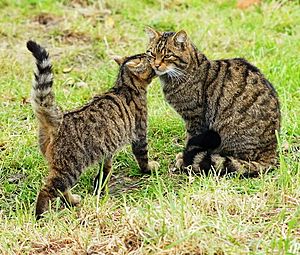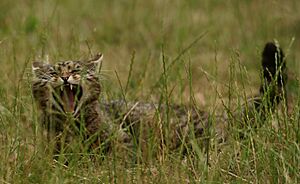Scottish wildcat facts for kids
Quick facts for kids Felis silvestris silvestris |
|
|---|---|
 |
|
| Female and kitten at the British Wildlife Centre | |
| Conservation status | |
| Scientific classification | |
| Kingdom: | Animalia |
| Phylum: | Chordata |
| Class: | Mammalia |
| Order: | Carnivora |
| Suborder: | Feliformia |
| Family: | Felidae |
| Subfamily: | Felinae |
| Genus: | Felis |
| Species: | F. silvestris |
| Subspecies: | F. s. silvestris |
| Trionomial name | |
| Felis silvestris silvestris | |
| Synonyms | |
|
|
The Scottish wildcat is a special type of European wildcat found in Scotland. It's often called the "Highland tiger" because of its wild nature and striped fur. These amazing cats once lived all over Great Britain.
Sadly, their numbers have dropped a lot since the early 1900s. This is mainly because they lost their homes (habitat loss) and were hunted. Now, you can only find them in northern and eastern Scotland. Studies using camera traps in the Scottish Highlands showed that wildcats prefer living in mixed woodland areas. On the other hand, feral and domestic cats are more often seen in grasslands.
The Scottish wildcat is now listed as Critically Endangered in the United Kingdom. This means they are at a very high risk of disappearing forever. A big threat is interbreeding with domestic cats. Because many wildcats now show signs of mixing with domestic cats, some experts believe they are functionally extinct in the wild. This means there might not be enough pure wildcats left to keep the population going on its own.
Contents
What Makes a Scottish Wildcat Special?
Scottish wildcats look a lot like domestic cats, but they are wilder and stronger. Male wildcats are about 57 to 64 centimeters long, not including their tails. Their tails are usually 30 to 35 centimeters long. Females are a bit smaller, around 50 to 57 centimeters long, with tails 28 to 34 centimeters long.
Males weigh between 3.7 and 7.2 kilograms, while females are lighter, weighing 2.3 to 4.6 kilograms. Their fur has clear stripes, like a tabby pattern. Their bushy tails have rings and a black tip. You can tell them apart from domestic cats by the stripes on their cheeks and back legs. They also don't have spots, white markings, or colored backs of their ears. They are heavier and have stronger bones and skulls than domestic cats.
Where Do Scottish Wildcats Live?
Scottish wildcats have been in Britain since the early Holocene period. This was a long time ago when the British Isles were connected to continental Europe. They used to be common all over Great Britain.
However, their numbers started to shrink. By the 16th century, they probably disappeared from southern England. By the mid-1800s, they were only found in parts of Wales and Northumberland. By 1915, they were limited to northwestern Scotland. After World War I, fewer gamekeepers hunted them, and new forests were planted. This helped the wildcat population grow again. But cities and industries stopped them from spreading back to southern Scotland.
Today, you can find them in places like the Cairngorms, the Black Isle, Aberdeenshire, the Angus Glens, and Ardnamurchan. They like living in forests, shrubland, and near the edges of woods. They avoid open areas like heather moorland and gorse bushes. They also prefer areas away from farms and don't like snow deeper than 10 centimeters.
How Scottish Wildcats Behave
Scientists have studied Scottish wildcats using radio collars. They found that wildcats are most active at night. Their activity decreases when the moon is bright or when it's windy.
Male wildcats have large areas they call home, and these areas often overlap with several female wildcats' homes. Female wildcats, however, usually don't share their home areas with other females. Adult cats have bigger territories than younger ones. They mark their areas using scent from their poop to let other cats know it's their space. In and around Cairngorms National Park, a wildcat's home range can be about 2.4 to 3.8 square kilometers.
Scottish wildcats mainly hunt European rabbits and field voles. Their scat (poop) has shown remains of rabbits, wood mice, and different types of voles and birds. If they catch more food than they can eat, they will bury it to save for later. This is called caching.
Reproduction and Life Cycle
Male Scottish wildcats can start having kittens when they are about 10 months old. Females can start even earlier, before they are 12 months old. Females usually have one estrous (heat) period in early March. Kittens are then born in early May after about 63 to 68 days of gestation (pregnancy). Sometimes, a female can have another heat period about a month later and have a second litter in August.
In the wild, mating happens between January and March. A female can have anywhere from one to eight kittens, but on average, they have about four kittens. They rarely give birth in winter. Kittens are born in a hidden den, often in cairns (piles of stones), under brush piles, or among tree roots. They open their eyes when they are 10 to 13 days old. Their eyes are blue at first and turn green around seven weeks of age.
Kittens start learning to hunt when they are 10 to 12 weeks old. They stop drinking their mother's milk around 14 weeks. They leave their mothers when they are about six months old. In the past, many kittens died in winter because they couldn't find enough food. In captivity, Scottish wildcats can live for 15 years. But in the wild, their lives are much shorter due to things like road accidents and diseases caught from feral domestic cats.
Threats to Scottish Wildcats
The Scottish wildcat is listed as Critically Endangered in the United Kingdom. The biggest threats are interbreeding with domestic cats, losing their homes (habitat loss), and being hunted.
A big debate has been happening in Aberdeenshire. A Swedish energy company, Vattenfall Wind Power, wants to build wind farms in Clashindarroch Forest. This forest is known as a "wildcat wonderland" by the Scottish government. The Scottish Wildcat Association says that building wind farms there would destroy the homes of at least 35 wildcats, which is a large part of the remaining population. As of 2021, over 800,000 people signed an online petition to protect the forest. Vattenfall, however, claims their project is not a threat.
Interbreeding with outdoor domestic cats is a serious problem. It's thought that almost all Scottish wildcats today have some domestic cat ancestors. Also, unvaccinated domestic cats can spread dangerous diseases to wildcats. These diseases include feline calicivirus, feline coronavirus, feline foamy virus, feline herpesvirus, feline immunodeficiency virus, and feline leukemia virus.
Scottish wildcats were also often killed in the past to protect game birds. They were once seen as pests.
Protecting the Scottish Wildcat
The Scottish wildcat gained legal protection under the United Kingdom's Wildlife and Countryside Act 1981. Since 2007, it has been a top priority species in the U.K. Biodiversity Action Plan. Feral cats, which are a threat to wildcats, can be killed all year round.
The Scottish Wildcat Conservation Action Plan was created to help save these cats. This plan set goals and responsibilities for different groups working to protect wildcats between 2013 and 2019. Scottish Natural Heritage helps manage this plan. In the wild, efforts include neutering feral cats and, in some cases, humanely ending the lives of diseased feral cats. This helps prevent interbreeding and the spread of sickness.
By 2014, the project identified six key areas where conservation efforts would likely be most successful. Work began in 2015 in places like Morvern, Strathpeffer, Strathbogie, Strathavon, Dulnain, and the Angus Glens. A remote and quiet area called the Ardnamurchan Peninsula was even made a special sanctuary for Scottish wildcats.
In 2018, the official conservation work was led by Scottish Wildcat Action. This group included government and academic organizations. They updated their list to five main priority areas: Strathbogie, the Angus Glens, Northern Strathspey, Morvern, and Strathpeffer. By 2019, experts believed the wildcat population in Scotland was no longer strong enough to survive on its own and was close to extinction.
However, there's new hope! In 2023, NatureScot allowed the release of wildcats that were raised in captivity into the Cairngorms region. The first 19 cats were released in early June 2023. In spring 2024, some of these released cats even had kittens, which is great news for their future!
Scottish Wildcats in Zoos
A special breeding program for Scottish wildcats has been set up. This program aims to breed wildcats in zoos and wildlife centers. Only wildcats that pass genetic and physical tests, showing less than 5% interbreeding with domestic cats, are included. Places like the Alladale Wilderness Reserve, Chester Zoo, British Wildlife Centre, Port Lympne Wild Animal Park, Highland Wildlife Park, New Forest Wildlife Park, and Aigas Field Centre are part of this effort.
Some groups, like the Captive Animals Protection Society, don't agree with this breeding program. They believe it has more to do with zoos having animals than with true conservation.
Despite this, the program has had successes. Six kittens were born at the Highland Wildlife Park in 2015. From 2011 to 2016, 15 Scottish wildcat kittens survived at this park. As of December 2016, about 80 Scottish wildcats were living in captivity.
Conservation Groups and Their Differences
Sometimes, different groups working to save the wildcats have different ideas about the best way to do it. In 2014, the Scottish Wildcat Association and Wildcat Haven disagreed with the efforts of Scottish Natural Heritage. In 2017, Scottish Wildcat Action, the official government group, defended itself from what it called unfair criticism from Wildcat Haven.
Scottish Wildcats in Culture
The Scottish wildcat is also known as the "Highland tiger." It has traditionally been a symbol of the wild Scottish landscape. The Scottish wildcat, or the Kellas cat, might have inspired the Scottish mythological creature called the Cat-sìth.
Since the 13th century, the wildcat has been a symbol for Clan Chattan, a Scottish clan. Most members of Clan Chattan have the Scottish wildcat on their crest badges. Their motto is "Touch not the cat bot a glove," where "bot" means 'without'. This motto refers to how fierce the Scottish wildcat is. Clan Chattan has been involved in helping save the Scottish wildcat since 2010.
In 2010, for the International Year of Biodiversity, the Royal Mail released a series of 10 stamps featuring endangered mammals. One of these stamps showed the Scottish wildcat.
The Scottish wildcat was also the main topic of a documentary film called The Tigers of Scotland, released in 2017. It was narrated by Scottish actor Iain Glen. The release of the captive-bred wildcats in 2024 was featured in a two-part documentary called Wildcats: Cait an ann Cunnart on BBC Alba. In 2019, Scottish wildcats were the main theme of the first issue of the Journal of Matters Relating to Felines, a magazine made by students at the University of Aberdeen.



